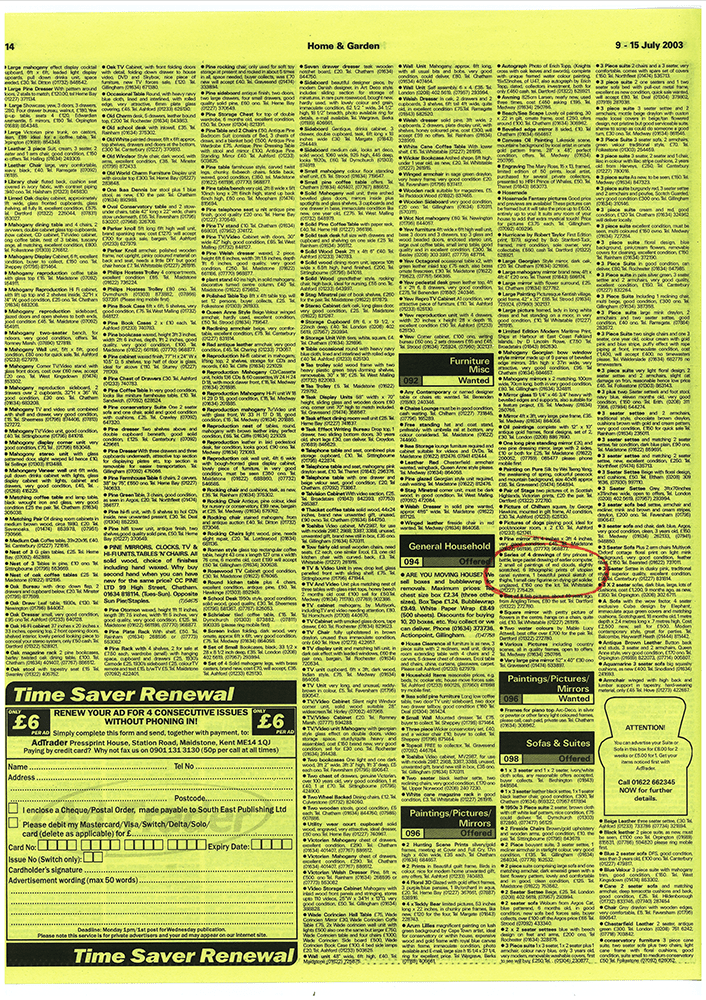

Transmitters (1991 – )
Pages from classified advertisement newspapers, showing advertisements placed by the artist and acrylic paint
407mm x 300mmA series of 40 different Transmitters were made, mostly from 1991-1999
♦
Excerpt from an interview with Mark Godfrey, (currently Senior Curator, International Art, Tate Modern) for ‘adam chodzko’, MAMbo catalogue, September 2007:
MG: Many of your earliest works involved a British publication called Loot which was a classified advert newspaper where people could place ads to sell unwanted items or to search for objects, services, and people. You created adverts that seemed to imply an alien character placing them, or that described impossible objects. Later, you took luxury advertisements (for diamond necklaces, for instance) and placed offers in Loot for the peripheral materials that appeared in those adverts. These works raise the question of your relationship to conceptual art. In 1966 for instance, for the work Detumescence, Dan Graham placed an ad in various publications asking for descriptions of ‘the typical emotional and physiological aspects of post-climax in the sexual experience of the human male.’ Later, Victor Burgin and Barbara Kruger deconstructed the language of fashion adverts. Did your work with Loot come out of any familiarity with these strategies? Were you interested in the possibilities of working with an expanded audience, even one which would not recognise your interventions as art? Were you primarily concerned with critiquing the materialism and associated language of Loot?
AC: I began the series of Loot advertisements works [Transmitters] as a by-product of a series of sculptures I was working on, around 1989/90. These were re-contextualised banal rural structures – for instance, a country stile turned into a piece of urban teenage counter-cultural domestic sports gear. I imagined a near future which would see these heart-warming objects of transition, previously utilised by middle-aged fell-walkers, now being re-appropriated by a fictitious new youth culture. As I attempted to finish one particular stile in multiple layers of glossy turquoise paint I realised, through this repetitive process, I was forgetting why I was making it and losing perspective too on how it would exist in dialogue with an audience. It became a transition point for me, the Transmitters becoming the immediate solution. I would telephone the Loot answer-machine and describe an object close to the kind I was making, but working within their house rules and language in order to mask the impossibility of the thing described. A few days later my free advertisement, if accepted, would be printed amongst thousands of others and perhaps someone, in looking for a cheap dining table would come across it as both stumbling block and possibility. Later I would show these pages in galleries, cut out and pinned to the wall, so that a second audience might try to visualise the object but only in relation to its imagined consumption by the first (Loot reader) audience. The Loot adverts were really about an economy of contact, immediacy and directness.
I then became interested in the fact that my words were vulnerable to mistranslation. Loot would filter the instructions and messages I supplied according to what made sense to the operator at the time: An advert I submitted containing a description of a “zulu shield and two spears” was printed as “…zulu shield and two spares”. In this way each work spun out of my control very quickly and this playing with misunderstanding seemed to be at the heart of the project. Other, later works using Loot [eg; Inverter ( Clearance Sale ) (1999)] explore slippages between different value systems and their respective languages. A fashion advertisement in Vogue or Harpers and Queen would have the constituent parts of its image sold off, piece by piece, in Loot. For a few days (since Loot would change its contents daily) these two systems would be in dialogue on different shelves of newspaper shops. While Burgin’s or Kruger’s deconstructions demonstrate the artists’ failure to be seduced by advertisements, my works begin by being entirely ‘seduced’ but then failing to recognise the hierarchies, commodities and values involved in an image, instead dismantling the misunderstood image and sharing it with anyone. So, in a Vogue advertisement for a Barbour jacket even the background rainfall had a potential use-value; I made it all equally ‘available’ and cheap! Together with many other works of mine, Transmitters and Inverter ( Clearance Sale ) suggest a maker who is ignorant not only of a culturally established hierarchy of objects and aesthetics, but also the fundamental difference between two and three dimensions, developing instead a peculiar intimate relationship with peripheral parts of an image, as if they were entirely tangible and mobile. Misunderstanding, not knowing the established order of things, is always crucial in the work, in that it opens up a space to imagine other realities and shows the contingency and perhaps the fragility too of our present reality.
♦
Related works:
In culo alla balena! [“Into the ass of a whale!” ] (2012)
Runners (2013)
We love you here, even though you are there (2012)
The God Look-Alike Contest (1991-1992)
We are Sorry (July 9, 2013)
Secretors (1993 – )




 Transmitters, installed in "Making People Disappear," Cubitt Gallery, London, 1993
Transmitters, installed in "Making People Disappear," Cubitt Gallery, London, 1993







